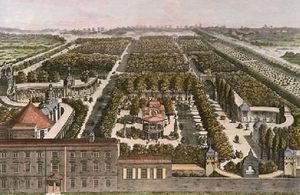Vauxhall Gardens

Vauxhall Gardens, in Kennington on the South bank of the Thames, were a pleasure garden accessed by boat until the opening of Regent Bridge (later Vauxhall Bridge) in 1816. Construction of this bridge began in 1809, on the site of a former ferry.
The first mention of the Gardens was in Pepys' diary in 1662. The site became Vauxhall Gardens in 1785 and admission was charged for its many attractions. The Gardens drew all manner of people and supported enormous crowds, with its paths being noted for romantic assignations. Tightrope walkers, hot-air balloon ascents, concerts and fireworks provided entertainment. The rococo "Turkish tent" became one of the Gardens' structures, the interior of the Rotunda became one of Vauxhall's most viewed attractions, and the chinoiserie style was a feature of several buildings. A statue depicting George Frederic Handel, erected in the Gardens, later found its way to Westminster Abbey. In 1817 the Battle of Waterloo was re-enacted, with 1,000 soldiers participating.[1]
The main walks were lit at night by hundreds of lamps. Over time more features and eyecatchers were added: additional supper boxes, a music room, a Chinese pavilion, a Gothic orchestra that accommodated fifty musicians, and ruins, arches, statues and a cascade. An admission charge was introduced from the beginning and later James Boswell wrote:
Vauxhall Gardens is peculiarly adapted to the taste of the English nation; there being a mixture of curious show, — gay exhibition, musick, vocal and instrumental, not too refined for the general ear; — for all of which only a shilling is paid; and, though last, not least, good eating and drinking for those who choose to purchase that regale. (Boswell's Life of Johnson)
The unlighted 'dark walks' or 'close walks' were known as a place for amorous adventures. Thomas Brown in "Works Serious and Comical in Prose and Verse" (1760) says:
The ladies that have an inclination to be private, take delight in the close walks of Spring-Gardens, where both sexes meet, and mutually serve one another as guides to lose their way; and the windings and turnings in the little wildernesses are so intricate, that the most experienced mothers have often lost themselves in looking for their daughters."
The supper-boxes, created within the colonnade around three sides of the Grove, were like theatre boxes, open at the front, and large enough to seat six or eight people on fixed benches around a table. A party of visitors to Vauxhall would order their supper immediately on entering, and they could choose either to dine at one of the tables scattered around the Grove or else to be allocated a supper-box, identifiable not only by a number, but by the painting hung in the back of each one, to which they could return after promenading in the gardens or listening to the music. Suppers were served from about 9 p.m., and consisted of light refreshments – thinly-carved cold meats and salads, pastries and cakes, as well as wines, beers, ciders and punch, all served by well-trained and speedy waiters. As suppers were being served, the great special effect of Vauxhall was enacted; a whistle was blown, the signal for lamp-lighters to hurry to their allotted stations around the Grove; at a second whistle, they would light cotton-wool fuses which had been set up during the day to guide the flame from one oil-lamp to another; in this way, it was said, thousands of lamps could be lit 'in an instant'– an effect which, before the days of electricity, must have been staggering.[2]
Gallery
-
Ivory Entrance Ticket For Vauxhall. 1808. This is the pass of Lloyds Evening Post, one of London's leading evening newspapers. It admits two people to the gardens.
-
An admission ticket from 1818
-
Evening Entertainment
-
Dancing at Vauxhall during the Regency
-
Supper boxes at Vauxhall, circa 1751
Vauxhall in LL
Two events have taken place in Vauxhall Gardens, Lord Wyck's Rout hosted by Walter Roydon on the 1st May and a [[Ridotto] on Tuesday the 14th May.
External References
<references>
- ↑ Wikipedia
- ↑ [http://www.vauxhallgardens.com/vauxhall_gardens_briefhistory_page.html Vauxhall Gardens: A Brief History




